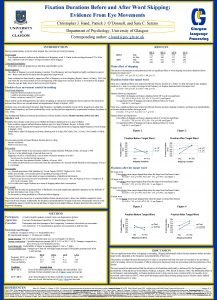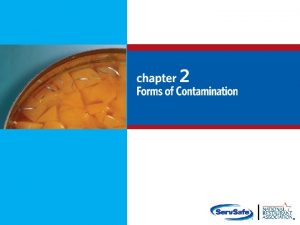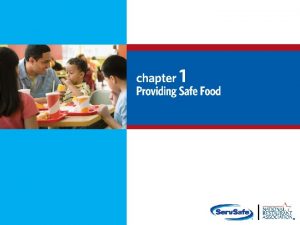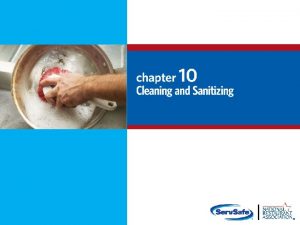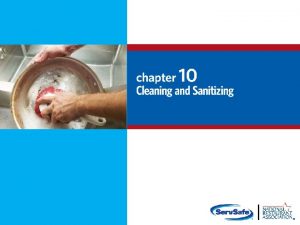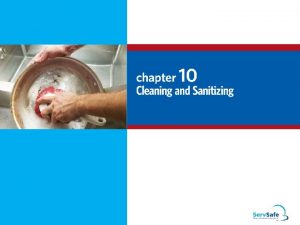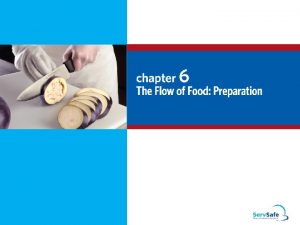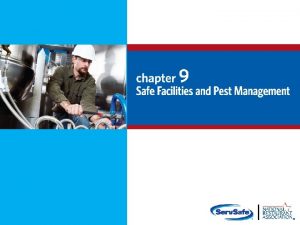DVD Lets watch a DVD 2 2 Review





































- Slides: 37


DVD Let’s watch a DVD… 2 -2

Review Let’s review 2 -3

DVD Review What are the four types of microorganisms that can cause foodborne illness? 2 -4 Viruses Bacteria Parasites Fungi

DVD Review What six conditions support the growth of bacteria? Food Acidity Temperature Time Oxyge Moisture 2 -5 n

DVD Review What two FAT TOM conditions will you be able to control in your operation? 2 -6 Time Temperature

DVD Review What is the temperature range of the temperature danger zone? 41°F to 135°F (5°C to 57°C) 2 -7

DVD Review What are some basic characteristics of bacteria? 2 -8 They live in and on our bodies The cannot be seen, smelled, or tasted They can grow rapidly if FAT TOM conditions are correct Controlling time and temperature can prevent them from causing illness

DVD Review What are some basic characteristics of viruses? 2 -9 They are carried by humans and animals They do not grow in food but they can be transferred through food People get viruses from food, water, or contaminated surfaces Foodborne illnesses from viruses typically occur through fecaloral routes They are not destroyed by normal cooking temperatures Practicing good personal hygiene can prevent viruses from causing illness

DVD Review Can this be a physical contaminant? A. Yes B. No 2 -10

DVD Review Can this be a physical contaminant? A. Yes B. No 2 -11

DVD Review Can this be a physical contaminant? A. Yes B. No 2 -12

DVD Review Is this a safe practice when handling chemicals? Why? A. Yes B. No 2 -13

DVD Review Is this a safe practice when handling chemicals? Why? A. Yes B. No 2 -14

DVD Review Is this a safe practice when handling chemicals? Why? A. Yes B. No 2 -15

Additional Content Some other things you should know… 2 -16

How Contamination Happens Contaminants come from a variety of places: 2 -17 Animals we use for food Air, contaminated water, and dirt People o Deliberately o Accidentally

How Contamination Happens People can contaminate food when: 2 -18 They don’t wash their hands after using the restroom They are in contact with a person who is sick They sneeze or vomit onto food or food-contact surfaces They touch dirty food-contact surfaces and equipment and then touch food

Biological Contamination Common symptoms of foodborne illness: Diarrhea Vomiting Fever Nausea Abdominal cramps Jaundice (yellowing of skin and eyes) Onset times: 2 -19 Depend on the type of foodborne illness Can range from 30 minutes to six

The “Big Six” Pathogens Food handlers diagnosed with illnesses from the “Big Six” pathogens cannot work in a foodservice operation while they are sick. 2 -20 Shigella spp. Salmonella Typhi Nontyphoidal Salmonella (NTS) Shiga toxin-producing Escherichia coli (STEC), also known as E. coli Hepatitis A Norovirus

Activity Teach the Bug 2 -21

Biological Toxins Origin: Naturally occur in certain plants, mushrooms, and seafood Seafood toxins: 2 -22 Produced by pathogens found on certain fish o Tuna, bonito, mahi o Histamine produced when fish is timetemperature abused Occur in certain fish that eat smaller fish that have consumed the toxin o Barracuda, snapper, grouper, amberjack o Ciguatera toxin is an example

Biological Toxins Illness: Symptoms and onset times vary with illness People will experience illness within minutes General symptoms: 2 -23 Diarrhea or vomiting Neurological symptoms o Tingling in extremities o Reversal of hot and cold sensations Flushing of the face and/or hives Difficulty breathing Heart palpitations

Deliberate Contamination of Food Groups who may attempt to contaminate food: Terrorists or activists Disgruntled current or former staff Vendors Competitors FDA defense tool: 2 -24 A. L. E. R. T.

Deliberate Contamination of Food Assure Make sure products received are from safe sources Look Monitor the security of products in the facility Employees Know who is in your facility Reports Keep information related to food defense accessible Threat 2 -25 Develop a plan for responding to suspicious activity or a threat to the operation

Responding to a Foodborne-Illness Outbreak Gather information o Ask the person for general contact information o Ask the person to identify the food eaten o Ask for a description of symptoms o Ask when the person first got sick Notify authorities o 2 -26 Contact the local regulatory authority if an outbreak is suspected

Responding to a Foodborne-Illness Outbreak 2 -27 Segregate product o Set the suspected product aside if any remains o Include a label with “Do Not Use” and “Do Not Discard” on it Document the information o Log information about suspected product o Include a product description, product date, lot number, sell-by date, and pack size

Responding to a Foodborne-Illness Outbreak Identify staff o Keep a list of food handlers scheduled at time of incident o Interview staff immediately Cooperate with authorities o 2 -28 Provide appropriate documentation Review procedures o Determine if standards are being met o Identify if standards are not working

Preventing Allergic Reactions To help prevent allergic reactions, service staff should: 2 -29 Describe menu items to guests, and identify any allergens in the item. Suggest menu items without the allergen. Clearly identify the guest’s order for kitchen and service staff. Deliver food separately to prevent cross-contact.

Avoiding Cross-Contact When preparing food for a guest with a known allergy, kitchen staff should: 2 -30 Check recipes and food labels for the allergen Use cleaned and sanitized utensils Wash hands and change gloves Use separate fryers and cooking oils Label packages correctly

Review Let’s review 2 -31

Review Who Am I? Norovirus 1. ___________ 2 -32 I can be transferred to food or equipment by food handlers with feces on their fingers People become contagious within a few hours of eating me I am often linked with ready-to-eat food Excluding staff who are vomiting or have diarrhea from an illness caused by me can stop me from spreading

Review Who Am I? Salmonella Typhi 2. ____________ 2 -33 I live in a person’s bloodstream and intestines I am commonly linked with ready-to-eat food and beverages I am in a person’s feces for weeks after symptoms have ended Washing hands and cooking food to minimum internal temperatures can prevent me

Review Who Am I? spp. 3. Shigella ___________ 2 -34 I am found in the feces of people I have infected Flies can transfer me I am linked with food easily contaminated by hands Excluding food handlers who have diarrhea from an illness caused by me can stop me from spreading

Review Who Am I? Hepatitis A 4. ___________ 2 -35 I am often linked with ready-to-eat food I’m often transferred to food by food handlers who have feces on their fingers Excluding staff with jaundice can prevent me from causing illness Normal cooking temperatures do not destroy me

Review Who Am I? 5. Shiga toxin-producing E. coli _____________________ 2 -36 I can be found in the intestines of cattle I produce toxins in a person’s intestines which cause illness I am found in ground beef and contaminated produce Excluding food handlers who have diarrhea from an illness caused by me can stop me from spreading

Review Who Am I? 6. Nontyphoidal Salmonella _____________________ 2 -33 Many farm animals carry me I can be found in a persons feces for weeks after symptoms are over I can be found in produce such as tomatoes, peppers and cantaloupes Cooking poultry and eggs to required minimum internal temperatures can prevent me.
 Let's watch a video
Let's watch a video What is integer
What is integer Let's have a review
Let's have a review Lets review cartoon
Lets review cartoon Nader amin-salehi
Nader amin-salehi Traditional and systematic review venn diagram
Traditional and systematic review venn diagram Chapter review motion part a vocabulary review answer key
Chapter review motion part a vocabulary review answer key Narrative review vs systematic review
Narrative review vs systematic review Ap gov review final exam review
Ap gov review final exam review The lets discuss
The lets discuss Let's remember simple present tense
Let's remember simple present tense Bing quiz recycling
Bing quiz recycling Lets play a game
Lets play a game What2learn
What2learn Lets hear from
Lets hear from Paper that lets the light shine through
Paper that lets the light shine through A train pulls into a station and lets off its passengers
A train pulls into a station and lets off its passengers Lets remember
Lets remember The water lets you in
The water lets you in Lets go hudro
Lets go hudro Letsbond
Letsbond American productivity and quality center
American productivity and quality center Shall asking for permission
Shall asking for permission My weekend plan sdn bhd
My weekend plan sdn bhd Let's spread the word
Let's spread the word Lets revisit
Lets revisit Let's play jeopardy
Let's play jeopardy Let's talk about sports
Let's talk about sports Lets revise
Lets revise Get ready for
Get ready for Lets remember
Lets remember Let's practice meaning
Let's practice meaning Cyberbullying let's fight it together
Cyberbullying let's fight it together Lets play bridge
Lets play bridge The word-skipping technique lets you figure out
The word-skipping technique lets you figure out Progressive lets
Progressive lets Let's make waves
Let's make waves Lets engage
Lets engage


































